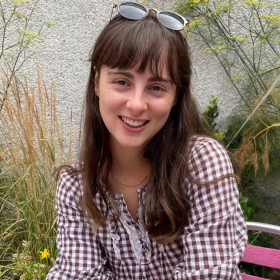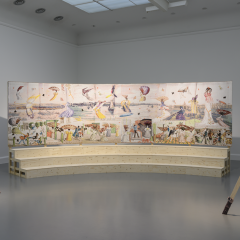Unravel: The Power and Politics of Textiles in Art (13 February – 26 May 2024) is a new exhibition at Barbican. It aims to shine a light on artists from the 1960s to today who have explored the transformative and subversive potential of textiles, harnessing the medium to ask charged questions about power: who holds it, and how can it be challenged and reclaimed?
I spoke with artist Mercedes Azpilicueta whose grand tapestry subverts a colonial myth and spotlights Indigenous Argentinian narratives.
Could you please introduce yourself?
I’m Mercedes Azpilicueta, and I’m a visual artist who also works in performance. I’m from Argentine and I live and work currently in Amsterdam. At Unravel, I’m exhibiting the 2019 work Lady’s Dreams or Stop RIght There Gentlemen!
Could you explain the concept of your work for Unravel?
This was a commission by the Fanada Museum in Eindhoven in the Netherlands by the invitation of Nick Eikons to participate in Positions Five. After so many years living in the Netherlands, I wanted to re-engage with the history of South America and Argentina. I focussed on the myth of the captive Lucía Miranda. This became a founding myth for the conquistador. The myth goes that a white woman is held captive by indigenous people and the colonisers rescue her. This story, this myth, has been told several times in paintings and books throughout history since the 17th century.
The version that inspired my tapestry was written and re-told by Eduarda Mansilla, a 19th century Argentinian writer. She tells the story from a completely different perspective. She centres Lucía, the women who in other narratives was depicted as passive at the hands of the ‘barbaic’ Indigenous population. However, in this story, she is a protagonist and Mansilla’s writing highlights her feelings, desires and the solidarity she creates with the Indigenous woman. It describes how they exchange knowledge and come up with their own language. This is also the first version of the story whereby the Indigenous Argentinian population are humanised and given agency.
How do the materials impact the story you’re trying to tell?
I have wanted to work with jaquard tapestry for a long time. I work with archival materials, such as engravings and lithographs from the 19th century in Argentina, the time when Mansilla was writing the story. When using jaquard tapestry, it’s almost like painting with threads. I only used 10 different coloured threads, but when they come together they create a much more diverse colour palette.
It was an interesting method to use, whereby the physical production mirrored the tapestry’s message. I wanted to bring together differen narratives about the myth. Through threads, it was possible to weave a wider understanding of the story.
What do you hope audiences will gain from experiencing this work?
I would like to let audiences know that we can re-write and re-tell the stories we hear. I went to school in Argentina, and the writer Eduarda Mansilla was never introduced to us. I want to let audiences know that we can challenge and contest long-held beliefs and narratives. I think the weaving together of different stories in a grand tapestry the right way to do this.









0 Comments